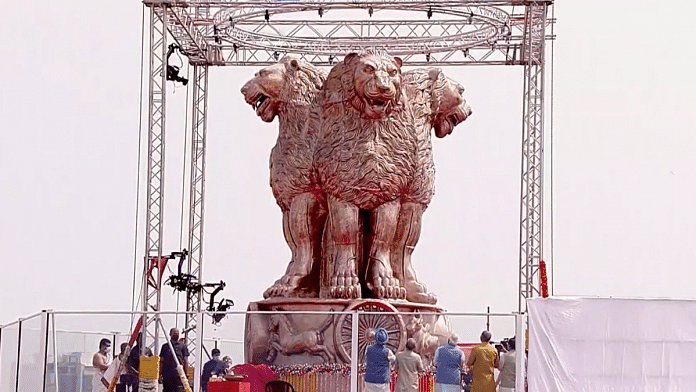New Delhi: A day after Prime Minister Narendra Modi unveiled the national emblem atop the new Parliament building, the opposition exploded in criticism, calling it an insult to the original and a distortion.
The Rashtriya Janata Dal’s official handle tweeted in Hindi, saying the lions in the new sculpture had a “man-eater tendency” while the originals had a mild expression.
Trinamool Congress Rajya Sabha MP Jawhar Sircar said the new lions were “snarling, unnecessarily aggressive and disproportionate”.
In light of this controversy, ThePrint takes a look at the history and significance of India’s national emblem.
Its history
The national emblem, adopted by the Republic of India on 26 January 1950, is an adaptation of the Lion Capital that stood atop the Ashoka Pillar in Uttar Pradesh’s Sarnath.
The pillar, built by the Mauryan Emperor Ashoka, stands at the site of Buddha’s First Sermon where he is believed to have shared the Four Noble Truths (the dharma or the law), and represents India’s sovereignty and its birth as a republic.
The original structure features four Asiatic lions seated back to back facing the four cardinal directions. The lion references the Buddha, who was known as the ‘Lion of the Shakyas’ (Shakyasimha) in reference to the clan of his birth, the Shakyas.
The lions are seated atop a circular abacus with a frieze of sculptures of a bull, a horse, a lion and an elephant facing the four directions. The sculptures are in high relief, and a dharma chakra can be seen between the bull and the horse.
Some Buddhist interpretations say the sculptures represent different stages of Buddha’s life, while some contend they represent the reign of Emperor Ashoka (himself a Buddhist), while the wheels are interpreted to represent his enlightened rule. Below the abacus is a base shaped like a lotus, an important symbol of Buddhism.
The Lion Capital was chosen by India in 1950 as a reaffirmation of independent and contemporary India’s “ancient commitment to world peace and goodwill“, values espoused by the Buddha and Emperor Ashoka through the Lion Capital.
The adaptation of the Lion Capital for India’s national emblem was sketched by Dinanath Bhargava, an artist chosen by legendary painter Nandalal Bose.
In the national emblem, only three of the lions are visible, and the lotus base is omitted. A bull and a horse are visible beneath the lions, separated by a dharma chakra. The motto “Satyameva Jayate” – Truth alone Triumphs – is written in Devanagari script below the profile of the Lion Capital.
Also read: National emblem installation should not be linked to religious ceremony: Left parties
Regulation surrounding the emblem
The national emblem is a symbol of the Indian government, and is the official seal of the President of India and the central and state governments. It is a part of the official letterhead of the Government of India, and appears on all Indian currency as well as passports.
Before the State Emblem of India (Prohibition of Improper Use) Act (2005) and the State Emblem of India (Regulation of Use) Rules (2007), the use of the national emblem was governed by a set of executive instructions, without any legal sanctions. However, these two acts now legally regulate its use.
The 2007 Act puts down rules regulating who may use the national emblem and how.
According to the Schedule of the 2005 Act, “The State Emblem of India shall conform to the designs as set out in Appendix I or Appendix II” of the Act.
However, the Act also mentions that the central government has the right “to do all such things (including the specification of design of the emblem and its use in the manner whatsoever) as the Central Government considers
necessary or expedient for the exercise of the foregoing powers.” The central government, therefore, has the freedom to make changes to the designs of the emblem specified in the Act’s appendices.
By making amendments to this act, the central government could legally change the national emblem entirely.
The new emblem
The national emblem cast unveiled by the prime minister atop the new Parliament building is a bronze structure, weighing around 9,500 kg and standing about 6.5 metres high. A supporting steel structure weighing 6,500 kg has been constructed to support the emblem.
The new national emblem has undergone eight different stages of trials, from computer graphic/ clay modelling to bronze polishing and casting. Further, over 100 artisans from all over the country worked on the design, and on crafting and casting the emblem for over six months.
According to the government, the difference in size and perspective between the original and the new was the reason behind the alleged dissimilarities in expression. Barring the size, the government has said, the new structure is an exact replica of the original emblem. Artists Sunil Deore and Romiel Moses, who designed the emblem cast, have also claimed that there has been no deviation from the original design.
The installation of the 9.5-tonne national emblem is a part of the government’s Central Vista Project, which aims to “strengthen governance infrastructure by building new facilities for India’s Parliament, an efficient and sustainable Central Secretariat to house all the ministries of the Government of India.”
Earlier, the Amar Jawan Jyoti at the India Gate was merged with the flame at the National War Memorial as part of this project.
Also read: Over 100 artisans from various parts of India worked on National Emblem: Officials



